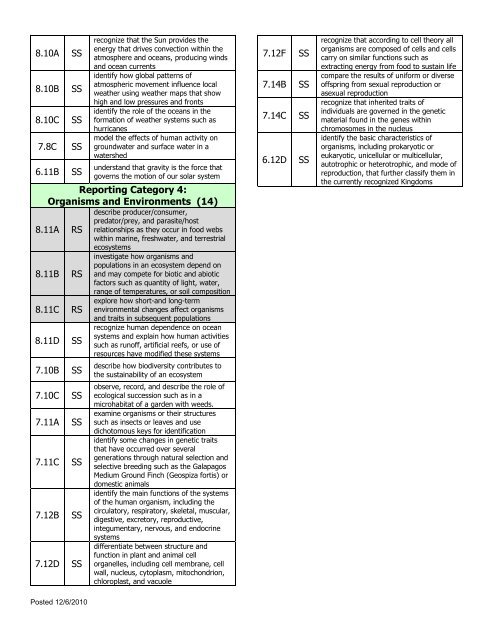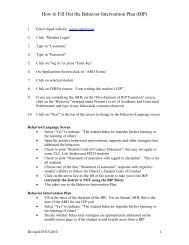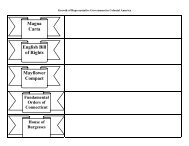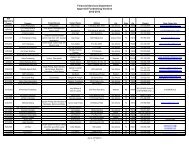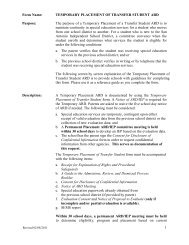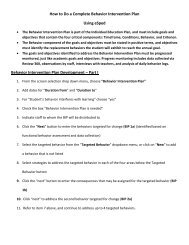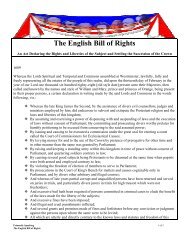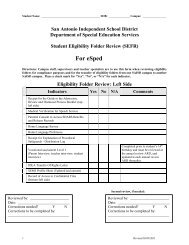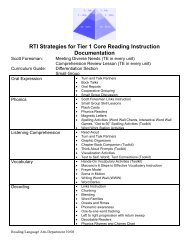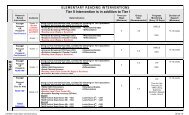8th Grade STAAR Science
8th Grade STAAR Science
8th Grade STAAR Science
You also want an ePaper? Increase the reach of your titles
YUMPU automatically turns print PDFs into web optimized ePapers that Google loves.
8.10A SS<br />
8.10B SS<br />
8.10C SS<br />
7.8C SS<br />
6.11B SS<br />
recognize that the Sun provides the<br />
energy that drives convection within the<br />
atmosphere and oceans, producing winds<br />
and ocean currents<br />
identify how global patterns of<br />
atmospheric movement influence local<br />
weather using weather maps that show<br />
high and low pressures and fronts<br />
identify the role of the oceans in the<br />
formation of weather systems such as<br />
hurricanes<br />
model the effects of human activity on<br />
groundwater and surface water in a<br />
watershed<br />
understand that gravity is the force that<br />
governs the motion of our solar system<br />
Reporting Category 4:<br />
Organisms and Environments (14)<br />
8.11A RS<br />
8.11B RS<br />
8.11C RS<br />
8.11D SS<br />
7.10B SS<br />
7.10C SS<br />
7.11A SS<br />
7.11C SS<br />
7.12B SS<br />
7.12D SS<br />
describe producer/consumer,<br />
predator/prey, and parasite/host<br />
relationships as they occur in food webs<br />
within marine, freshwater, and terrestrial<br />
ecosystems<br />
investigate how organisms and<br />
populations in an ecosystem depend on<br />
and may compete for biotic and abiotic<br />
factors such as quantity of light, water,<br />
range of temperatures, or soil composition<br />
explore how short-and long-term<br />
environmental changes affect organisms<br />
and traits in subsequent populations<br />
recognize human dependence on ocean<br />
systems and explain how human activities<br />
such as runoff, artificial reefs, or use of<br />
resources have modified these systems<br />
describe how biodiversity contributes to<br />
the sustainability of an ecosystem<br />
observe, record, and describe the role of<br />
ecological succession such as in a<br />
microhabitat of a garden with weeds.<br />
examine organisms or their structures<br />
such as insects or leaves and use<br />
dichotomous keys for identification<br />
identify some changes in genetic traits<br />
that have occurred over several<br />
generations through natural selection and<br />
selective breeding such as the Galapagos<br />
Medium Ground Finch (Geospiza fortis) or<br />
domestic animals<br />
identify the main functions of the systems<br />
of the human organism, including the<br />
circulatory, respiratory, skeletal, muscular,<br />
digestive, excretory, reproductive,<br />
integumentary, nervous, and endocrine<br />
systems<br />
differentiate between structure and<br />
function in plant and animal cell<br />
organelles, including cell membrane, cell<br />
wall, nucleus, cytoplasm, mitochondrion,<br />
chloroplast, and vacuole<br />
7.12F SS<br />
7.14B SS<br />
7.14C SS<br />
6.12D SS<br />
recognize that according to cell theory all<br />
organisms are composed of cells and cells<br />
carry on similar functions such as<br />
extracting energy from food to sustain life<br />
compare the results of uniform or diverse<br />
offspring from sexual reproduction or<br />
asexual reproduction<br />
recognize that inherited traits of<br />
individuals are governed in the genetic<br />
material found in the genes within<br />
chromosomes in the nucleus<br />
identify the basic characteristics of<br />
organisms, including prokaryotic or<br />
eukaryotic, unicellular or multicellular,<br />
autotrophic or heterotrophic, and mode of<br />
reproduction, that further classify them in<br />
the currently recognized Kingdoms


